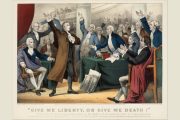
Item: The New York Times for March 22 reported: “Now that landmark legislation overhauling the health insurance system is about to become law, addressing Social Security’s solvency could well become the next big thing for President Obama and Congressional Democrats.” Social Security, said Jackie Calmes of the Times, “now stands as the likeliest source of the large savings needed to bring projected annual deficits to sustainable levels, many budget analysts agree.”
However, said the Times, “some liberals” have already “begun mobilizing to oppose any changes to Social Security benefits.”
Item: On March 24, a press release was issued by the Frances Perkins Center in Newcastle, Maine. The center, said the release, “has received a grant from the National Academy of Social Insurance through funds provided by the Ford Foundation for the creation of a multimedia celebration of the 75th anniversary of Social Security. Part of the project includes a national competition for personal stories about the effect of this landmark federal program on the lives of Americans.”
Continued the release: “More than 51 million Americans today are recipients of Social Security, a program created during the Great Depression by President Franklin D. Roosevelt to help people needing financial assistance. The program’s foremost champion was FDR’s Secretary of Labor, Frances Perkins…. The enactment of Social Security in 1935 ushered in, for the first time, the experience of the ‘Golden Years’ for retirees.” The center “will celebrate” the anniversary “by highlighting the ways the program has been an essential anchor for economic security and stability for American families.”
Correction: It would take a phenomenal public-relations effort to portray an expensive wealth-transfer program — which in actuality reeks of insolvency, theft, pyramid scheming, unsustainability, and the fostering of dependency — as the generator of Golden Years for all American seniors.
Well, you could lie. In fact, that’s how we got into this fix in the first place. According to the 2009 Social Security and Medicare Trustees Reports, the combined unfunded liability of the two programs has reached almost $107 trillion, or about seven times the size of the U.S. economy. (Medicare’s unfunded liabilities are about five times the amount of Social Security, which we are focusing on here. If anything, the Medicare situation is more depressing.) Unfunded liabilities, in essence, refer to the cavernous difference between promised benefits and expected revenues.
There’s nothing golden about that. That’s a lead weight on the economy.
Social Security is in effect a “legal” Ponzi scheme. Because it has taxing power, it can require workers to kick into the chain-letter operation that would be illegal if run by ordinary citizens. Because Social Security is enforced by federal law, the pyramid scheme has been sustained for decades. Postponing a fix will make a collapse even uglier. Yet it is still verboten, at the very least, to allow younger Americans to buy into private retirement investments with some of their Social Security tax dollars.
Social Security is kept afloat — though it is taking on considerable water and getting closer to capsizing — by requiring current workers to “contribute” from their earnings. And those “contributions” have skyrocketed over the years. Most Americans — nearly 80 percent of the total — now pay more in Social Security taxes than they do in income taxes this year. The program already chews up about 23 percent of the federal budget.
Yet the largest government program on the planet is now officially in the red. Despite the illusions that have been fostered by the government from the days of FDR, there are no individual accounts set aside for those who have been required to pay. Your payments have been immediately handed out to current beneficiaries and to fund other government needs. And beginning this year, according to government projections, more monies will be paid out in Social Security benefits than are taken in by the program.
There were surpluses in the past, but rather than set aside any surpluses, the government spent it and issued an IOU to itself. Don’t try this at home. Now, even that imaginary paper surplus has evaporated as demand has gone up and payments tailed off. Even the New York Times begrudgingly admitted in a March 24 story (way down in paragraph 15): “Although Social Security is often said to have a ‘trust fund,’ the term really serves as an accounting device, to track the pay-as-you-go program’s revenues and outlays over time.”
As Doug Bandow of the Cato Institute recently put it:
The crisis is now, since the vaunted “trust fund” is filled with non-recourse government bonds — essentially worthless pieces of paper. There’s no there there when it comes to financing future benefits. Either payments have to come down or taxes have to go up, unless we adopt real reform centered around personal accounts.
For all of our paying into the system, keep in mind that there is no guarantee that we will get back what we have put in, or anything at all for that matter. The Supreme Court has already ruled that Americans have no legal and contractual property right to their “contributions.” In Flemming v. Nestor, the High Court held: “To engraft upon Social Security a concept of ‘accrued property rights’ would deprive it of the flexibility and boldness in adjustment to ever-changing conditions which it demands.” Nope, you don’t own that account, regardless of FDR’s promises.
To garner support when the program was first being pushed, the scheme was not sold as an entitlement or even presented as just another tax. Rather, Americans were told, this was a way for them to look after their own old age. In practice, it has meant that millions of older Americans have been rendered dependent on the government, many now solely reliant on Washington’s political largesse. This is no accident, since greater dependency means larger, more intrusive government and tighter controls.
You could say President Roosevelt hedged a bit on the facts, but that would be to present a false picture. Rather, to be more to the point: FDR lied. Repeatedly. For instance, the President said: “Get these facts straight. The Act provides for two kinds of insurance for the worker. For that insurance both the employer and the worker pay premiums — just as you pay premiums on any other insurance policy. Those premiums are collected in the form of taxes. The first kind of insurance covers old age. Here the employer contributes one dollar in premium for every dollar of premium contributed by the worker; but both dollars are held by the government solely for the benefit of worker in his old age.”
One can stretch imaginations and definitions to the breaking point, but Social Security is still not true insurance. There is no pool of assets managed for the exclusive benefit of its contributors under a fixed set of rules. About the only truth in FDR’s claims is that the government can force both you and your employer to pay. (Moreover, Roosevelt and generations of liberals since prefer not to note that both halves of this tax really come from the workers since the employers take their supposed shares from the workers’ total compensation package, leading to lower wages.) Worse, when Social Security taxes were first imposed, it meant that it cost more to hire workers — a particularly cruel twist in the Great Depression when unemployment was rampant.
It turned about to be another verification of the point made by 19th-century French economist Frederic Bastiat: “The State is the great fictitious entity by which everyone seeks to live at the expense of everyone else.” The difficulty is it doesn’t work. Even Roosevelt’s Treasury Secretary Henry Morgenthau admitted to the House Ways and Means Committee in May 1939: “We have tried spending money. We are spending more money than we have ever spent before, and it does not work…. We have never made good on our promises. I say, after eight years [it was actually during the seventh year of the New Deal] of this administration, we have just as much unemployment as when we started … and an enormous debt to boot.”
Then, as now, to get less of something, you tax it. For fewer jobs, increase the payroll tax.
The Frances Perkins Center’s press release somehow omits the fact that no Social Security checks at all were paid during the 1930s. Author Jim Powell, in his incisive analysis of the New Deal, does observe that, “through the payroll tax,” Social Security “increased the cost of employing people and thereby helped prolong high unemployment.”
In FDR’s Folly (2003), Powell writes:
Beginning January 1, 1942, individuals who were sixty-five and had quit work could collect monthly benefit payments. Consequently, Social Security wouldn’t do any good for elderly poor people during the Great Depression. [Emphasis in original.] The aim was to build up the Old Age Reserve Account before the government started issuing benefit checks.
It certainly seemed unfair that individuals who paid into Social Security would be unable to collect benefits just because they wanted to continue working, but one of the ulterior purposes of the Social Security Act was to get older people out of the workforce and create openings for younger people who were unemployed.
One would imagine that the Frances Perkins Center isn’t looking for this kind of silver-haired tale to boost the 75th anniversary of Social Security.




